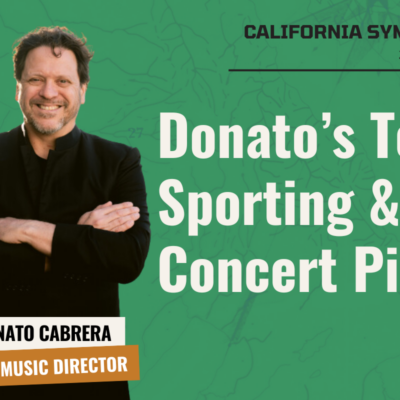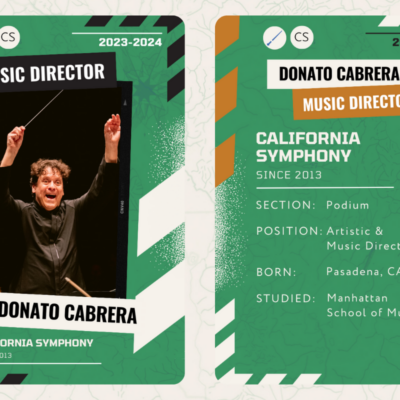 California Symphony Composer-in-Residence Katherine Balch composed Artifacts for New England Conservatory friend and colleague Robyn Bollinger, based on four pieces that are core to solo violin repertoire.
California Symphony Composer-in-Residence Katherine Balch composed Artifacts for New England Conservatory friend and colleague Robyn Bollinger, based on four pieces that are core to solo violin repertoire.
Each movement in Artifacts takes its inspiration from diverse works composed between the early 1800s and 1976.
By Donato Cabrera, California Symphony Music Director
“Robyn and I have been friends since our undergraduate years at New England Conservatory, and I’ve been wanting to write her a piece for a long time. I wanted to take the repertoire Robyn and I love and have shared conversations over, and turn it into something not only in my own voice, but also into something I hope elevates/highlights the incredible personality Robyn brings to her performative practice. While there are not really direct ‘quotes,’ there is often the illusion of quotation, or referencing the pieces in some personal way.”—Katherine Balch
Movement I: Prelude (After Berio)
Luciano Berio (1925-2003)
A prolific and much admired Italian composer, Berio was known primarily for his ground-breaking work in electronic music, for example, Thema (Omaggio a Joyce); his orchestral work Sinfonia, which was written for the 125th anniversary of the New York Philharmonic and premiered by Leonard Bernstein; and his fourteen Sequenzas, which are pieces for solo instruments and were all written for very close friends of Berio. His Sequenza VIII was written in 1976 for the Italian violinist, Carlo Chiarappa, and, as Berio writes, “is built around two notes (A and B), which – as in a chaconne – act as a compass in the work’s rather diversified and elaborate itinerary….Sequenza VIII, therefore, becomes inevitably a tribute to that musical apex which is the Ciaccona from Johann Sebastian Bach’s Partita in D minor.”
This same two-note compass acts as the building blocks in the first movement of Artifacts.”—Katherine Balch
Movement II: Aria (After Paganini)
Niccolò Paganini (1782-1840)
It wasn’t until well into the 20th century that the virtuoso wasn’t also expected to be a virtuoso in composition. Why? The main reason, of course, is that the art form was still primarily a creative, rather than a re-creative one. Almost all concerts were always presentations of entirely new music, rather than something that was written in the past. Therefore, if a new young gun, like a Chopin, Mendelssohn, Liszt, or a Paganini, wanted to show off their prodigious talents on their respective instrument, it was expected that their talents be shown through the compositions they wrote for themselves, not how unique and refreshing they interpreted a composition from the past, like we expect today. Paganini’s 24 Caprices are a perfect example.
Paganini’s Sixth Caprice is more virtuosically understated than other pieces in the collection, but no less challenging. The violinist plays double trills (sustaining one note while simultaneously trilling another on a different string), which create a haunting and yearning effect. This technique is focal point of the second movement of Artifacts. I want to capture and try to share a bit of the magic I experienced listening to the music I love, filtered through my own voice.”—Katherine Balch
Movement III: Intermezzo (After Ysaÿe)
Eugène Ysaÿe (1858-1931)
Like Paganini before him, the Belgian violinist Ysaÿe was another virtuoso who was a noted composer. As his health declined in later years, however, Ysaÿe focused on teaching and on conducting. He was offered the position of music director of the New York Philharmonic in 1898, but turned it down, and from 1918-1922 was the music director of the Cincinnati Symphony Orchestra. For his Six Sonatas for Solo Violin, op. 27, Ysaÿe, like Katherine Balch in Artifacts, uses as a source of inspiration a set of works written in the past (the eponymous Bach compositions) and created works that are considered some of the most important solo works for the violin from this, or any, time period.
The Sarabande from Ysaÿe’s fourth sonata begins with a beautiful melody played pizzicato (plucked) by the violin. This pizzicato melody inspires the heart of the third movement of Artifacts.”—Katherine Balch
Movement IV: Dance (After Sciarrino)
Salvatore Sciarrino (b.1947)
Sciarrino is the only living composer of the four and, like Berio, has written a large body of work, from Chamber music to several operas, for which he has also written the libretti. His compositional education was mostly autodidactic, which probably accounts for his thoroughly unique and original voice. His Sei Capricci (Six Caprices) for solo violin were written in the same year (1976) as Berio’s Sequenza VIII and, furthermore, are an homage to Paganini’s 24 Caprices.
While Sciarrino’s music is often very quiet and sounds quite sparse, there is often a lot of activity bubbling underneath a seemingly hushed musical surface. In the final movement of the violin concerto, that activity it brought to the forefront in a lively, agitated dance. In this way, the last movement of Artifacts is a sort of antithetical homage to the sound worlds experienced in Sciarrino’s music.”—Katherine Balch
Artifacts by Composer-in-Residence Katherine Balch receives is world premiere at the California Symphony’s May 5 season finale EPIC BRUCKNER at the Lesher Center for the Arts in Walnut Creek. Tickets are $42-$72 ($20 for students 25 and under), available online or through the Lesher Center Box Office at 925.934.7469.



